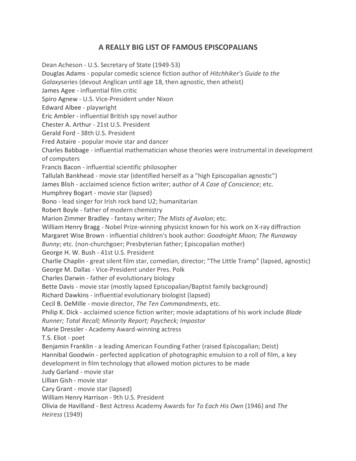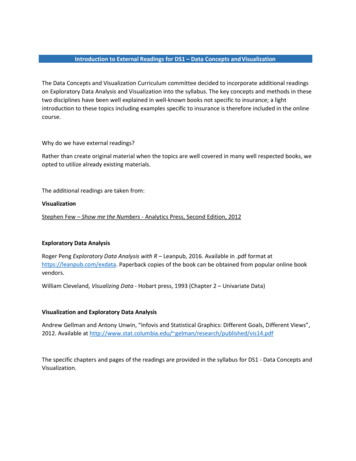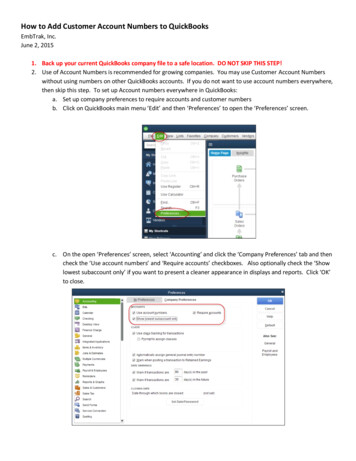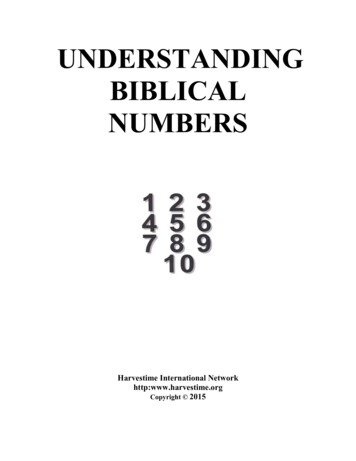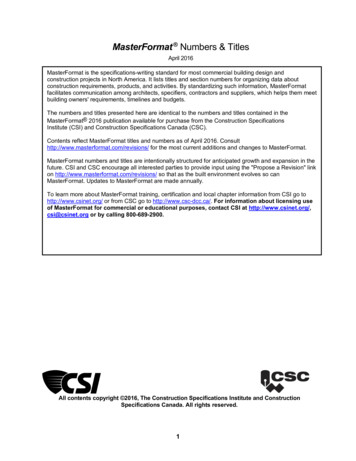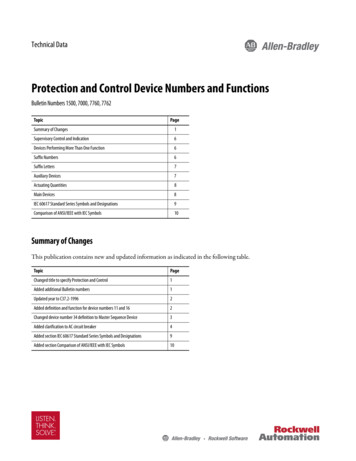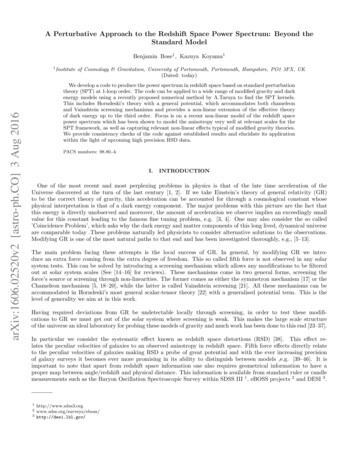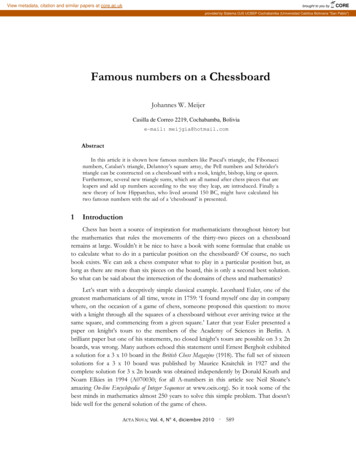
Transcription
View metadata, citation and similar papers at core.ac.ukbrought to you byCOREprovided by Sistema OJS UCBSP-Cochabamba (Universidad Católica Boliviana "San Pablo")Famous numbers on a ChessboardJohannes W. MeijerCasilla de Correo 2219, Cochabamba, Boliviae-mail: meijgia@hotmail.comAbstractIn this article it is shown how famous numbers like Pascal’s triangle, the Fibonaccinumbers, Catalan’s triangle, Delannoy’s square array, the Pell numbers and Schröder’striangle can be constructed on a chessboard with a rook, knight, bishop, king or queen.Furthermore, several new triangle sums, which are all named after chess pieces that areleapers and add up numbers according to the way they leap, are introduced. Finally anew theory of how Hipparchus, who lived around 150 BC, might have calculated histwo famous numbers with the aid of a ‘chessboard’ is presented.1IntroductionChess has been a source of inspiration for mathematicians throughout history butthe mathematics that rules the movements of the thirty-two pieces on a chessboardremains at large. Wouldn’t it be nice to have a book with some formulae that enable usto calculate what to do in a particular position on the chessboard? Of course, no suchbook exists. We can ask a chess computer what to play in a particular position but, aslong as there are more than six pieces on the board, this is only a second best solution.So what can be said about the intersection of the domains of chess and mathematics?Let’s start with a deceptively simple classical example. Leonhard Euler, one of thegreatest mathematicians of all time, wrote in 1759: ‘I found myself one day in companywhere, on the occasion of a game of chess, someone proposed this question: to movewith a knight through all the squares of a chessboard without ever arriving twice at thesame square, and commencing from a given square.’ Later that year Euler presented apaper on knight’s tours to the members of the Academy of Sciences in Berlin. Abrilliant paper but one of his statements, no closed knight’s tours are possible on 3 x 2nboards, was wrong. Many authors echoed this statement until Ernest Bergholt exhibiteda solution for a 3 x 10 board in the British Chess Magazine (1918). The full set of sixteensolutions for a 3 x 10 board was published by Maurice Kraitchik in 1927 and thecomplete solution for 3 x 2n boards was obtained independently by Donald Knuth andNoam Elkies in 1994 (A070030; for all A-numbers in this article see Neil Sloane’samazing On-line Encyclopedia of Integer Sequences at www.oeis.org). So it took some of thebest minds in mathematics almost 250 years to solve this simple problem. That doesn’tbide well for the general solution of the game of chess.ACTA NOVA; Vol. 4, Nº 4, diciembre 2010· 589
590 · Meijer: Famous numbers on a ChessboardWhat other chess related questions could we ask ourselves? There are many but inthis article I restrict myself to the question which famous numbers can be constructedon a chessboard with a rook, knight, bishop, king or queen. The first answers to thisquestion turned out to be quite surprising. I will show how four simple questions lead toPascal’s triangle, the Fibonacci numbers, Catalan’s triangle, Delannoy’s square array, thePell numbers and Schröder’s triangle. En passant I present a new theory of howHipparchus, who lived around 150 BC, might have calculated his two famous numberswith the aid of a ‘chessboard’.2Blaise Pascal’s triangleThe first problem: how many paths can a rook take from square a1 to square h8 ifit can only move to the north and east?Figure 1:1: Pascal’s triangle.For the answer to this question see figure 1. If we rotate the board 135 degrees tothe right we observe that on the upper half of this board Pascal’s triangle appears(A007318). Addition of the numbers in the horizontal rows of this triangle leads to thepowers of two (A000079). Addition of the numbers on the chessboard with a knightleads to the Fibonacci numbers (A000045; a1 1; b1 1; c1 a2 2; d1 b2 3;e1 c2 a3 5; f1 d2 b3 8; g1 e2 c3 a4 13; h1 f2 d3 b4 21; etc.).Pascal’s triangle is the most famous of all number triangles. In fact, it was knownlong before him but Blaise Pascal’s Traité du triangle arithmétique (1654) is considered to bethe most important source of information. An amazing number of relations can beformulated for this triangle and Donald Knuth observed that if someone finds a newidentity that no one except the discoverer will get excited about it. So this will probablyalso be the case for the ‘chess sums’ that I have added to the OEIS entree for the Pascaltriangle (apparently eight of them are new). I named these sums after chess pieces thatare leapers and all of them add up numbers on the chessboard according to the way they
ACTA NOVA; Vol. 4, Nº 4, diciembre 2010Ensayos · 591leap: knight ( 5 or 1,2; square root of five), fil ( 8 or 2,2), camel ( 10 or 3,1), giraffe( 17 or 4,1) and zebra ( 13 or 3,2) (A180662). The fil was used in shatranj, the Islamicpredecessor of chess, the camel, giraffe and zebra are fairy chess pieces and the knightstill plays its classical role in modern chess; see The Oxford Companion to Chess (1992) byDavid Hooper and Kenneth Whyld.Leonardo of Pisa, who is better known as Fibonacci, introduced the Hindu-Arabicnumber system in Europe with his book Liber Abaci (1202). It caused a revolution in theway we calculate. Nowadays Fibonacci’s fame rests primarily on a sequence whichappears in this book and was named after him by Édouard Lucas. An expression for thegeneral term of this sequence was found some five hundred years later by Abraham deMoivre in 1730 who linked it to the golden ratio (A001622).De Moivre was a respected scientist with a passion for chess. He met Isaac Newtonfor the first time just after Newton’s Philosophiae Naturalis Principia Mathematica (1687)appeared, a book that is regarded as one of the most important works in the history ofscience. They became friends and spent their evenings together debating philosophicalmatters. De Moivre promptly mastered the new mathematics of the Principia with theresult that Newton is said to have referred persons asking him about his work to DeMoivre ‘who knows all that better than I do’; see Maty’s biography of Abraham de Moivre,translated, annotated and augmented (2007) by David Bellhouse and Christian Genest.De Moivre was a regular customer of Slaughter’s Coffee House in London wherehe met fellow Huguenots, would give advice on risk and must have played chess withother customers. A solution of the knight’s tour from his hand appeared in Récréationsmathématiques et physiques (1725) by his teacher Jacques Ozanam and in The Doctrine ofChances (1718) he included an engraving on which a chessboard that has been cast asidecan be seen. It is possible that De Moivre met François-André Danican Philidor whenhe played a match with Phillip Stamma at Slaughter’s in 1747. Shortly afterwardsPhilidor’s L’analyze des échecs (1749) was published in London, a book that did for chesswhat the Principia did for physics.According to legend the first numbers that appeared on the very first chessboardwere the powers of two. Grand Vizier Sissa ben Dahir, who invented chess for theIndian king Shirham around the year 600 AD, proposed for his reward the doublinggame with grains of wheat. The doubling game implies that the king had to put onegrain on a1, two on b1, four on a2, eight on c1, sixteen on b2, thirty-two on a3, etc.‘And is that all you wish, Sissa, you fool?’ the astonished king must have shouted only todiscover that there wasn’t enough wheat around to fulfil Sissa’s request.3Eugène Catalan’s triangleThe second problem: how many paths can a rook take from square a1 to square h8if it can only move to the north and east but cannot move below the a1-h8 diagonal?
592 · Meijer: Famous numbers on a ChessboardFigure 2:2: Catalan’s triangle.Catalan’s triangle answers this question (see figure 2; A009766). The Catalannumbers appear on the a1-h8 diagonal (A000108). You find these numbers again whenyou add the numbers in the horizontal ranks or rows. A bishop, which can only move tothe north-west and north-east, also leads to this triangle (via A053121).In Catalan numbers with Applications (2009) Thomas Koshy attributes the relationbetween these rook paths and the Catalan triangle to Henry G. Forder who publishedhis findings in 1961. On the front page of Koshy’s book one possible rook path isdepicted. Eugène Catalan discovered ‘his’ numbers in 1838. They have beenrediscovered many times by others not only after but also before Catalan. The numberof combinatorial interpretations that Richard Stanley gives on his website is anincredible 190, dd. 21-08-10. Occasionally Catalan numbers turn up in situations that arerelated to chess. In Queue problems revisited (2005) Stanley presents the number ofsolutions of a series-helpmate problem by Eero Bonsdorff and Kauko Väisänen whichappears to be C7 429 and he shows how to extend this number of solutions to C17 129644790.4Henri Delannoy’s square arrayThe third problem: how many paths can a king (queen) take from square a1 tosquare h8 if (s)he can only move to the north, east and north-east?Delannoy’s square array answers this question (see figure 3; A008288). Adding thenumbers in the triangle rows, after rotating the board 135 degrees to the right, leads tothe Pell numbers (A000129) and adding the numbers of the square array with a knightleads to the tribonacci numbers (A000073). The numbers on the a1-h8 diagonal are thecentral Delannoy numbers (A001850).
ACTA NOVA; Vol. 4, Nº 4, diciembre 2010Ensayos · 593Figure 3:3: Delannoy’s square array.Our third problem appeared in Emploi de l’échiquier pour la résolution de divers problèmesde probabilité (1889) by Henri Delannoy. Charles-Ange Laisant suggested the queen walk,Delannoy found the solution and Édouard Lucas called the number array ‘Delannoy’sarithmetical square’ and that name stuck. Édouard Lucas liked games. He was theauthor of the four volume book Récréations Mathématiques (1881-1894). Delannoy andLaisant were two of the editors. In his first book the eight-queen problem can be found.This problem was first published by Max Bezzel in the Deutsche Schachzeitung (1848).You have to place eight queens on an 8 x 8 chessboard in such a way that no queen isattacked by another and determine the number of such positions. Carl Friedrich Gauss,the ‘Prince of Mathematics’, saw this problem two years later in a newspaper and solvedit with some difficulty. Lucas describes among others the method used by Gauss andproudly presents the complete set of 92 solutions. He expresses his interest in thesolutions for n non-attacking queens on an n x n chessboard for n 9, 10, 11 and 12 andcomes back to this question in note IV at the end of the first book. Lucas mentions thatfor n 9 Pieter Hendrik Schoute found 352 solutions and that for n 10 his devotedfriend Henri Delannoy found 724 solutions. Both sets are complete. Nowadays thisproblem has been solved with the aid of computers for values of n up to 26 (A000170).The Pell equation plays an important role in finding good rational approximationsfor the square root of positive integers; see Number Theory (1984) by André Weil. ThePell equation got its name around 1765 from Euler and it is generally believed that hemade a mistake. A better name would certainly be the BBB equation after Brahmagupta(635), Bhaskara (1150) and William Brouncker (1658) who developed the classicalmethods for solving the ‘Pell equation’, but attempts to change the terminologyintroduced by Euler have always proved futile.The Pell numbers P(n) can be linked with the positive and negative Pell equationsof ‘the square root of two’ and it can be shown that the formula [1 P(n)/P(n 1)] givesgood rational approximations for the square root of two. This formula leads to a curious
594 · Meijer: Famous numbers on a Chessboardobservation: we have seen that Delannoy’s square array gives us the Pell numbers so wemight say that just by looking at how a king, or a queen for that matter, moves on achessboard allows us to calculate the square root of two.Eric Temple Bell placed in Men of Mathematics (1937) Newton, Gauss andArchimedes at the top of his list of the greatest mathematicians of all time but somebelieve that he should have included Euler. We are all indebted to Euler, one of themost prolific mathematicians ever, of whom Pierre Simon Laplace said ‘c’est notremaître à tous’. We have already met three of them so let’s make a short detour and meetthe fourth, Archimedes, a man with the appearance and mind of a chess player.In Parallel Lives: The Life of Marcellus (75) the Greek historian Plutarch wrote thefollowing words about Archimedes: ‘He placed his whole affection and ambition inthose purer speculations where there can be no reference to the vulgar needs of life.’and ‘Oftentimes his servants got him against his will to the baths, to wash and anointhim, and yet being there, he would ever be drawing with his fingers lines upon his nakedbody, so far was he taken from himself and brought into trance, with the delight he hadin the study of geometry.’ Apparently quite a few chess players live parallel lives. A niceexample of one of his purer speculations is Archimedes’ cattle problem. A manuscriptwith this highly original problem was discovered in 1773 by Gotthold Ephraim Lessing,the librarian of the Wolfenbüttel library. Apparently one of his competitors had dared tosuggest that he could handle large numbers better than the master himself and thisrequired an appropriate reaction. Archimedes presented the cattle problem in a shortpoem around 250 BC. In his poem he asked his friends to determine the size of theherd of the Sun god that grazes at Sicily. It goes without saying that the Sun god has alarge herd. In order to calculate the number of white, black, dappled and brown bullsand cows you have to solve two problems. Solving the first part shows that you are notignorant and solving the second part wins you the supreme wisdom prize. The latterpart requires that you solve a difficult version of Pell’s equation and leads to a totalnumber of cattle requiring no less than 206545 digits (A096151); see Solving the Pellequation (2002) by Hendrik Willem Lenstra Jr.In order to get a feeling for this number let’s use the doubling game once again: weput one cow or bull on a1, two on b1, four on a2, eight on c1, sixteen on b2, thirty-twoon a3, etc. To allocate the whole herd we need a chessboard of no less than 828 x 828squares. A rather large chessboard I admit but remember that we are dealing with theherd of the Sun god. One might argue, as several nineteenth century German scholarsdid, that there aren’t enough bulls and cows on earth and that they might not fit on theisle of Sicily but, as Lessing remarked, the Sun god will have coped with it.Archimedes must have been keenly aware of the fact that his problem led to animpossible large number and there must have been a mischievous smile on his facewhen he sent the poem to his friend Eratosthenes who lived in Alexandria where he wasthe chief librarian at the Mouseion library.
ACTA NOVA; Vol. 4, Nº 4, diciembre 20105Ensayos · 595Ernst Schröder’s triangleThe fourth problem: how many paths can a king (queen) take from square a1 tosquare h8 if (s)he can only move to the north, east and north-east but with the extracondition that (s)he cannot move below the a1-h8 diagonal?Figure 4:4: Schröder’s triangle.Schröder’s triangle answers this question (see figure 4; A033877). On the a1-h8diagonal the large Schröder numbers appear (A006318). Addition of the numbers in theranks or rows leads to the little Schröder numbers (A001003).While studying the numbers that appear in Schröder’s triangle, I noticed that thesum of the numbers in the ninth rank or row is 103049. Quite surprisingly this numberappeared around 150 BC in a statement of the Greek astronomer Hipparchus about thenumber of compound propositions that can be made from only ten simple propositionsbut it is a mystery how he calculated it. The situation becomes even more mysterious ifwe use a fil, the predecessor of the bishop, to add up numbers. A fil, Arabic forelephant, moves diagonally and leaps over one square. Walking upwards along the a1-h8diagonal addition with a fil leads to the sequence: 1, 2, 7 ( 6 1), 28 ( 22 6), 121( 90 30 1), 550, 2591, 12536, 61921, 310954, etc. (A010683). The tenth numberagrees closely with the second number that was mentioned by Hipparchus in hisstatement, namely 310952. So the question arises: ‘Did Hipparchus know a game thatlooked like chess?’In Hipparchus, Plutarch, Schröder and Hough (1997) Richard Stanley describes thehistory of the two numbers given by Hipparchus that were transmitted to us byPlutarch. A scholarly account of the original Greek sources can be found in On theShoulders of Hipparchus (2003) by Fabio Acerbi. It is interesting to note that Acerbi startshis article with the sentence: ‘To write about combinatorics in ancient Greekmathematics is to write about an empty subject.’ The effect of the two numbers givenby Hipparchus is, according to Acerbi, disruptive and the whole issue of ancient Greeks
596 · Meijer: Famous numbers on a Chessboardcombinatorics must be reconsidered. The possibility that a game that looked like chessplayed a role isn’t considered by Acerbi and Stanley. The latter, whom I asked for hisopinion, feels that it is farfetched to think that Hipparchus knew of any game similar tochess. He added that Plutarch states Hipparchus’ results in terms of compoundpropositions that can be made from ten simple propositions; Thus is seems thatHipparchus was thinking in terms of Stoic logic, as discussed by Acerbi. Stanleyconcluded that there is no reason to believe that a game like chess was involved.Figure 5:5: Achilles and Ajax.Let’s look at the situation from a somewhat different perspective. Board gameswere popular in ancient Greece. Around 530 BC, the potter painter Exekias made abeautiful amphora with Achilles (left) and Ajax (right) playing a board game, see figure5. What board games did the ancient Greeks play? Roland G. Austin starts his articleabout Greek board games (1940) with the sentence: ‘The study of Greek board-games isalmost wholly inconclusive, owing to the scanty and extremely imprecise evidenceavailable.’ So very little can be said about the games they played. We can, however,speculate that somebody close to Hipparchus had a petteia board and using one of thepieces he asked himself the same question I formulated above. Obviously for a king-likepiece the terms in the a-column (file) must all be one and the other terms on the boardmust be the sums of three terms, i.e. c5 c4 b4 b5 and e5 d4 d5 e4 with e4 0;simple additions that reflect the king’s movements. After that he had to add the terms inthe rows (ranks) in two ways just like I did and show his results to Hipparchus.Hipparchus, with his knowledge of the intricacies of Stoic logic, would of course haverecognized these numbers instantly and must have used this fairly simple method tocalculate the larger numbers that reached us through the writings of Plutarch. A mysterysolved? It is possible.
Ensayos · 597ACTA NOVA; Vol. 4, Nº 4, diciembre 2010References[1]F. Acerbi, On the Shoulders of Hipparchus. Archive for History of ExactSciences 57, pp. 465-502, 2003. http://stl.recherche.univ-lille3.fr/[2]R. G. Austin, Greek board games, 1940. http://www.gamesmuseum.uwaterloo.ca/[3]E. T. Bell, Men of Mathematics, 1937.[4]D. Bellhouse and Ch. Genest, Maty’s biography of Abraham de Moivre,translated, annotated and augmented, 2007. http://projecteuclid.org/[5]F.A. Danican Philidor, L’analyze des échecs, 1749.[6]H. Delannoy, Emploi de l’échiquier pour la résolution de divers problèmes deprobabilité, Association Française, Paris XVIII, pp. 43-52, 1889.[7]Leonardo Fibonacci, Liber Abaci, 1202.[8]D. Hooper and K. Whyld, The Oxford Companion to Chess, 1992.[9]Th. Koshy, Catalan numbers with Applications, 2009.[10] H. W. Lenstra Jr., Solving the Pell equation, Notices Amer. Math. Soc. 49, pp.182–192, 2002. 11] E. Lucas, Récréations Mathématiques, 1881-1894.[12] De Moivre, The Doctrine of Chances, 1718.[13] Newton, Philosophiae Naturalis Principia Mathematica, 1687.[14] Ozanam, Récréations mathématiques et physiques, 1725.[15] Pascal, Traité du triangle arithmétique, 1654.[16] edu/Plutarch/marcellu.htmlofMarcellus,75.[17] N.J.A. Sloane, The On-Line Encyclopedia of Integer Sequences, 1996-2011, atwww.oeis.org. A070030 (Closed knight’s tours). A007318 (Pascal’s triangle).A000079 (Powers of two). A000045 (Fibonacci numbers). A180662 (The goldentriangle). A001622 (The golden ratio). A009766 (Catalan’s triangle). A000108(Catalan numbers). A053121 (Catalan’s triangle variant). A008288 (Delannoy’ssquare array). A000129 (Pell numbers). A000073 (Tribonacci numbers). A001850(Central Delannoy numbers). A000170 (Non-attacking queens). A096151(Archimedes’ cattle problem). A033877 (Schröder’s triangle). A006318 (LargeSchröder numbers). A001003 (Little Schröder numbers). A010683 (Hipparchusnumbers).[18] R. Stanley, Hipparchus, Plutarch, Schröder and Hough, American Math. Monthly104, pp. 344-350. 1997. http://math.mit.edu/ rstan/pubs/
598 · Meijer: Famous numbers on a Chessboard[19] R. Stanley, Queue problems revisited, Suomen Tehtäväniekat 59, no. 4, pp. 193203, 2005. http://math.mit.edu/ rstan/pubs/[20] Weil, Number Theory, An approach through history from Hammurapi toLegendre, 1984.
on a chessboard with a rook, knight, bishop, king or queen. The first answers to this question turned out to be quite surprising. I will show how four simple questions lead to Pascal’s triangle, the Fibonacci numbers, Catalan’s triangle, Delannoy’
